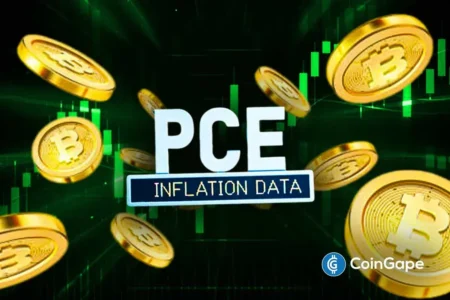The Rise of Bitcoin as a Store of Value Amidst Dollar Decline
Veteran trader Peter Brandt recently highlighted a concerning trend regarding the U.S. dollar’s purchasing power, which has drastically declined since 1971. With inflation ravaging currency values, Brandt advocates for Bitcoin as the leading candidate for long-term value preservation. According to his analysis, the U.S. dollar has experienced a staggering 97% drop in value over the past five decades, primarily due to excessive money supply growth. Brandt’s insights, shared widely on X, have ignited discussions about Bitcoin’s potential as a superior store of value compared to traditional assets like gold.
The Decline of the U.S. Dollar
In a revealing chart, Brandt showcased the decline in the dollar’s value from $1.00 in 1971 to approximately $0.031 anticipated in 2025. This 97% depreciation starkly illustrates the detrimental effects of inflation and currency debasement in the context of an expanding fiat currency system. While many consider gold a reliable store of value, Brandt confidently argues that Bitcoin will surpass gold as the ultimate asset for preserving wealth over the coming decades.
The implications of this argument are particularly salient in today’s economic landscape, where inflation and currency depreciation remain pressing global concerns. Central banks around the world have ramped up money supply in an attempt to stimulate growth, ultimately undermining the long-term value of national currencies. This scenario aligns with the growing sentiment among many investors who see Bitcoin as a viable hedge against inflation, capitalizing on its unique attributes.
Bitcoin Versus Gold
Gold has long been hailed as a safe haven asset that offers protection against inflation and currency fluctuations. Despite its historical success, Brandt’s perspective suggests a significant shift in how investors might view value preservation in the future. While gold undoubtedly has its merits, particularly as a tangible asset, Bitcoin offers distinct advantages that align with the digital age. One key aspect is Bitcoin’s fixed supply cap of 21 million coins, an attribute that starkly contrasts with the inflationary nature of fiat currencies that can be printed indiscriminately.
This restricted supply positions Bitcoin as an attractive alternative for investors seeking to protect their wealth from the erosive forces of inflation. As countries grapple with enormous debt and economic uncertainty, the narrative around Bitcoin as a "digital gold" is gaining traction, especially among younger investors who are more inclined toward cryptocurrency investments.
Predictions on Bitcoin’s Future
Aside from discussing the dollar’s decline, Brandt also forecasted an imminent peak for Bitcoin, suggesting that it could hit a tradable top within the next six weeks. He pointed out that Bitcoin price cycles have demonstrated a pattern of moving from lows to highs, with the halving event acting as a pivotal midpoint. Historical data supports this claim, indicating that significant market moves often align with these cycle behaviors.
Brandt’s projections have garnered attention, especially amidst ongoing discussions about market dynamics and Bitcoin’s price performance. Investors closely monitoring these developments might find themselves at a strategic crossroads, contemplating whether to enter or fortify their positions in the cryptocurrency market before the anticipated peak.
The Perspective of Industry Leaders
Adding weight to Brandt’s assertions, Michael Saylor, Executive Chairman of Strategy, also views Bitcoin as the foundational asset that corporate treasuries should consider in their portfolios. During a recent interview, Saylor articulated that Bitcoin exemplifies "digital capital," asserting that it possesses characteristics enabling it to outperform traditional equity benchmarks, including the S&P 500, over time.
Saylor’s recognition of Bitcoin’s potential as a low-risk, high-return asset further underscores its appeal in the institutional investment landscape. His company, Strategy, is taking proactive measures to expand its Bitcoin holdings, including a significant $4.2 billion offering aimed at enriching their Bitcoin treasury. Such moves indicate a growing consensus among influential figures that Bitcoin could reshape investment paradigms as we know them.
The Broader Implications for Investors
As inflation remains an unavoidable concern for investors and financial institutions alike, the conversation surrounding Bitcoin continues to evolve. By viewing it through the lens of wealth preservation and inflation hedging, stakeholders may recognize the advantages of adding Bitcoin to their portfolios. While traditional assets like gold still hold value, the digital realm offers innovative solutions to modern-day financial challenges.
Moreover, regulatory clarity and technological advancements in the cryptocurrency sphere may bolster Bitcoin’s adoption as a mainstream asset. Investors who remain informed about market conditions and technical analysis will be better equipped to navigate this rapidly changing landscape.
Conclusion
Peter Brandt’s recent warning about the declining purchasing power of the U.S. dollar emphasizes the pressing need for alternatives that can withstand the test of time. As he pushes Bitcoin as the future of value preservation, the crypto community remains charged with optimism about its potential to outperform traditional assets like gold. Industry leaders like Michael Saylor reinforce this view, further solidifying Bitcoin’s status as a formidable force in finance. With its unique properties and growing institutional acceptance, Bitcoin is positioned not merely as a speculative asset but as a cornerstone for future wealth generation, making it a valid consideration for any serious investor looking to protect against inflation and currency decay.
















